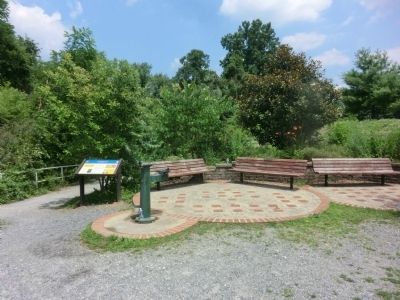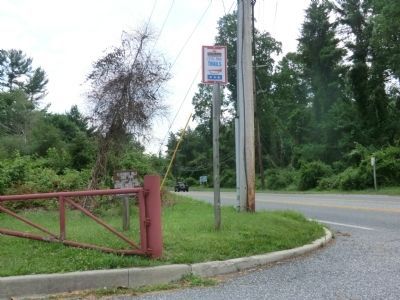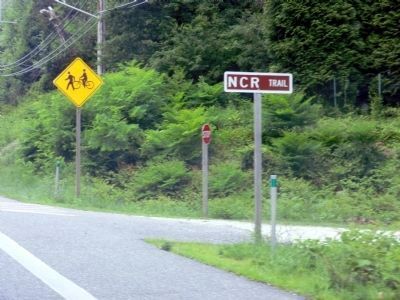Cockeysville in Baltimore County, Maryland — The American Northeast (Mid-Atlantic)
Gilmor's Raid
Capturing Cockeysville
— Early's 1864 Attack on Washington —
In June 1864, Confederate Gen. Robert E. Lee sent Gen .Jubal A. Early’s corps from the Richmond battlefields to the Shenandoah Valley to counter Union Gen. David Hunter’s army. After driving Hunter into West Virginia, Early invaded Maryland to attack Washington D.C., draw Union troops from Richmond, and release Confederate prisoners held at Point Lookout. On July 9, Early ordered Gen. Bradley T. Johnson’s cavalry brigade eastward to free the prisoners. The next day, Johnson sent Maj. Harry Gilmer’s regiment to raid the Baltimore area. Union Gen. Lew Wallace delayed Early at the Battle of Monocacy on July 9. Federal reinforcements soon strengthened the capital’s defenses. Early attacked there near Fort Stevens on July 11-12 and then withdrew to the Shenandoah Valley with the Federals in pursuit. He stopped them at Cool Spring on July 17-18. Despite failing to take Washington or free prisoners, Early succeeded in diverting Federal resources.
Before the Battle of Monocacy, Confederate Gen. Jubal A. Early ordered Gen. Bradley T. Johnson to lead his cavalry brigade east toward Baltimore. Johnson’s mission was to cut railroad and telegraph communications north of Baltimore, then move south to free Confederate prisoners at Point Lookout. The first part of this mission was daring; the second part was impossible.
Johnson sent 25 mounted troopers under Maj. Harry Gilmor to seize Cockeysville, where they arrived on Sunday, July 10. They set up pickets and burned the Northern Central Railway’s bridge across the Big Gunpowder Falls, located about half a mile north of here.
Gilmor’s small force then rode east, where the men attempted to set fire to the Philadelphia, Wilmington & Baltimore Railroad Bridge across the Gunpowder River. Johnson’s command, meanwhile, moved south to burn Maryland Governor Augustus Bradford’s house. Plans to liberate Point Lookout were abandoned, and Johnson and Gilmor soon rejoined Early’s army.
“Repeated reports confirm the presence of the enemy on York Road at Cockeysville and Towsontown. …All reports tend to the theory that a force intends to cut the Philadelphia road. The report of the destruction of the Gunpowder Bridge on the Northern Central is reliable.” — Union Gen. William H. Morris, July 10, 1864
[Sidebar:]
With connections to Harrisburg and beyond, the Northern Central Railway was vital for supplying the Union armies in Maryland, Virginia and Washington D.C. Despite being damaged, first by Baltimore authorities in 1861 and then by Confederate raiders in 1863 and 1864, the railroad nearly tripled its revenue during the war. In November 1863, the Northern Central was among several railroads to convey President Abraham Lincoln to Gettysburg to dedicate the national cemetery. Two years later, the railroad helped transport the fallen president to his final resting place in Springfield, Illinois.
Erected by Maryland Civil War Trails.
Topics and series. This historical marker is listed in these topic lists: Railroads & Streetcars • War, US Civil. In addition, it is included in the Maryland Civil War Trails series list. A significant historical month for this entry is April 1922.
Location. 39° 30.113′ N, 76° 38.021′ W. Marker is in Cockeysville, Maryland, in Baltimore County. Marker can be reached from Paper Mill Road (Maryland Route 145) 0.3 miles east of Arrowwood Road, on the left when traveling east. The marker is on the grounds of the Gunpowder Fall State Park and at the entrance to the North Central Railroad Trail. Touch for map. Marker is in this post office area: Cockeysville MD 21030, United States of America. Touch for directions.
Other nearby markers. At least 8 other markers are within 3 miles of this marker, measured as the crow flies. North Central Railroad Trail (a few steps from this marker); Lime Kiln (approx. 0.4 miles away); Phoenix (approx. 1.4 miles away); Hayfields (approx. 2.1 miles away); Sparks (approx. 2.6 miles away); "...To Those Who Served"
(approx. 2.6 miles away); Third and Last County Almshouse (approx. 2.9 miles away); White Marble Block (approx. 2.9 miles away). Touch for a list and map of all markers in Cockeysville.
Credits. This page was last revised on February 3, 2024. It was originally submitted on July 12, 2014, by Don Morfe of Baltimore, Maryland. This page has been viewed 1,680 times since then and 61 times this year. Last updated on July 8, 2022, by Carl Gordon Moore Jr. of North East, Maryland. Photos: 1, 2, 3, 4. submitted on July 12, 2014, by Don Morfe of Baltimore, Maryland. • Bernard Fisher was the editor who published this page.



